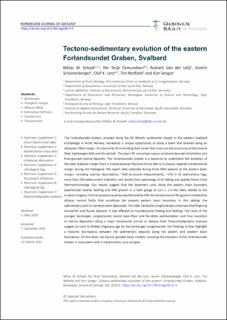| dc.contributor.author | Schaaf, Niklas W. | |
| dc.contributor.author | Osmundsen, Per Terje | |
| dc.contributor.author | van der Lelij, Roelant | |
| dc.contributor.author | Schönenberger, Jasmin | |
| dc.contributor.author | Lenz, Olaf K. | |
| dc.contributor.author | Redfield, Thomas Fitzmaurice | |
| dc.contributor.author | Senger, Kim | |
| dc.date.accessioned | 2023-01-13T12:58:43Z | |
| dc.date.available | 2023-01-13T12:58:43Z | |
| dc.date.created | 2022-03-24T12:26:42Z | |
| dc.date.issued | 2021 | |
| dc.identifier.citation | Norwegian Journal of Geology. 2021, 100 (4), . | en_US |
| dc.identifier.issn | 2387-5844 | |
| dc.identifier.uri | https://hdl.handle.net/11250/3043391 | |
| dc.description.abstract | The Forlandsundet Graben, situated along the NE Atlantic continental margin in the western Svalbard archipelago in Arctic Norway, represents a unique opportunity to study a basin that evolved along an obliquely rifted margin. It is bound by N–S-trending fault zones that cross-cut the structures of the Eocene West Spitsbergen-fold-and-thrust-belt. The basin fill comprises coarse continent-derived siliciclastics and finer-grained marine deposits. The Forlandsundet Graben is a keystone to understand the evolution of the west Svalbard margin from a transpressional fold-andthrust-belt to a sharply tapered transtensional margin during the Paleogene. We report data collected during three field seasons at the eastern basin margin, including outcrop descriptions, ~500 structural measurements, ~370 m of sedimentary logs, more than 100 paleocurrent indicators and results from palynology, K–Ar dating and apatite fission track thermochronology. Our results suggest that the basement units along the eastern basin boundary experienced reverse faulting and illite growth in a fault gouge at 53.5 ± 1.0 Ma likely related to the Eurekan orogeny. This transpressional phase was followed by NW–SE transtensional rifting which initiated the oblique normal faults that constitute the present eastern basin boundary. In this setting, the sedimentary units on Sarsøyra were deposited. The older Sarsbukta conglomerate comprises interfingering alluvial-fan and fluvial deposits. It was affected by transtensional folding and faulting. The rocks of the younger Sarstangen conglomerate record basin-floor and fan-delta sedimentation and thus transition to marine deposition along a major intrabasinal normal or oblique fault. Palynostratigraphic analyses suggest an Early to Middle Oligocene age for the Sarstangen conglomerate. Our findings further highlight a maturity discrepancy between the sedimentary deposits along the eastern and western basin boundaries. On this basis, we discuss possible basin models, including the evolution of the Forlandsundet Graben in association with a metamorphic core complex. | en_US |
| dc.language.iso | eng | en_US |
| dc.publisher | Geological Society of Norway | en_US |
| dc.title | Tectono-sedimentary evolution of the eastern Forlandsundet Graben, Svalbard | en_US |
| dc.title.alternative | Tectono-sedimentary evolution of the eastern Forlandsundet Graben, Svalbard | en_US |
| dc.type | Peer reviewed | en_US |
| dc.type | Journal article | en_US |
| dc.description.version | publishedVersion | en_US |
| dc.source.pagenumber | 39 | en_US |
| dc.source.volume | 100 | en_US |
| dc.source.journal | Norwegian Journal of Geology | en_US |
| dc.source.issue | 4 | en_US |
| dc.identifier.doi | 10.17850/njg100-4-4 | |
| dc.identifier.cristin | 2012252 | |
| cristin.ispublished | true | |
| cristin.fulltext | original | |
| cristin.qualitycode | 1 | |
